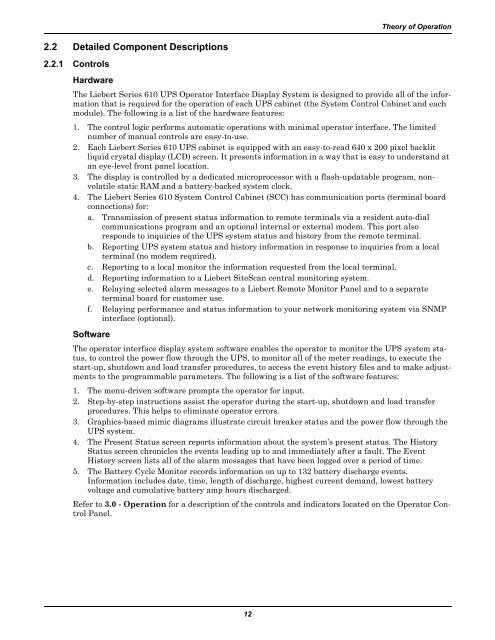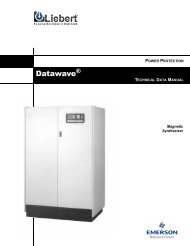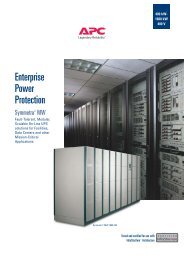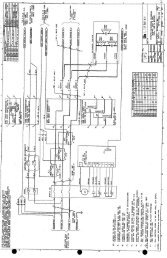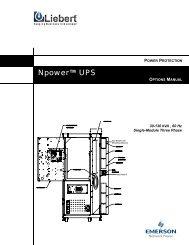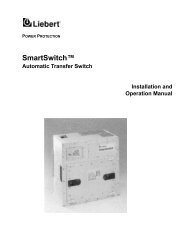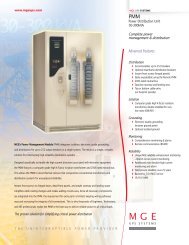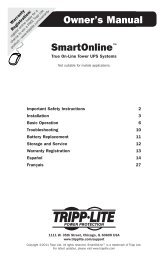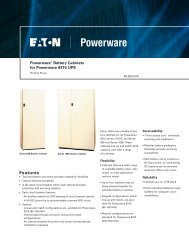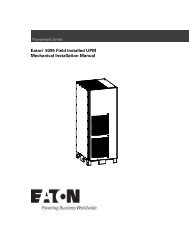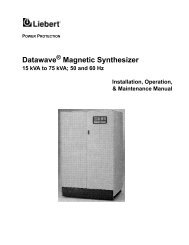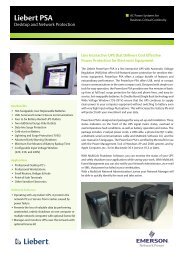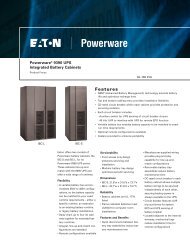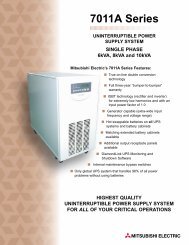Liebert® Series 610™ UPS - Jonweb.net
Liebert® Series 610™ UPS - Jonweb.net
Liebert® Series 610™ UPS - Jonweb.net
You also want an ePaper? Increase the reach of your titles
YUMPU automatically turns print PDFs into web optimized ePapers that Google loves.
Theory of Operation<br />
2.2 Detailed Component Descriptions<br />
2.2.1 Controls<br />
Hardware<br />
The Liebert <strong>Series</strong> 610 <strong>UPS</strong> Operator Interface Display System is designed to provide all of the information<br />
that is required for the operation of each <strong>UPS</strong> cabi<strong>net</strong> (the System Control Cabi<strong>net</strong> and each<br />
module). The following is a list of the hardware features:<br />
1. The control logic performs automatic operations with minimal operator interface. The limited<br />
number of manual controls are easy-to-use.<br />
2. Each Liebert <strong>Series</strong> 610 <strong>UPS</strong> cabi<strong>net</strong> is equipped with an easy-to-read 640 x 200 pixel backlit<br />
liquid crystal display (LCD) screen. It presents information in a way that is easy to understand at<br />
an eye-level front panel location.<br />
3. The display is controlled by a dedicated microprocessor with a flash-updatable program, nonvolatile<br />
static RAM and a battery-backed system clock.<br />
4. The Liebert <strong>Series</strong> 610 System Control Cabi<strong>net</strong> (SCC) has communication ports (terminal board<br />
connections) for:<br />
a. Transmission of present status information to remote terminals via a resident auto-dial<br />
communications program and an optional internal or external modem. This port also<br />
responds to inquiries of the <strong>UPS</strong> system status and history from the remote terminal.<br />
b. Reporting <strong>UPS</strong> system status and history information in response to inquiries from a local<br />
terminal (no modem required).<br />
c. Reporting to a local monitor the information requested from the local terminal.<br />
d. Reporting information to a Liebert SiteScan central monitoring system.<br />
e. Relaying selected alarm messages to a Liebert Remote Monitor Panel and to a separate<br />
terminal board for customer use.<br />
f. Relaying performance and status information to your <strong>net</strong>work monitoring system via SNMP<br />
interface (optional).<br />
Software<br />
The operator interface display system software enables the operator to monitor the <strong>UPS</strong> system status,<br />
to control the power flow through the <strong>UPS</strong>, to monitor all of the meter readings, to execute the<br />
start-up, shutdown and load transfer procedures, to access the event history files and to make adjustments<br />
to the programmable parameters. The following is a list of the software features:<br />
1. The menu-driven software prompts the operator for input.<br />
2. Step-by-step instructions assist the operator during the start-up, shutdown and load transfer<br />
procedures. This helps to eliminate operator errors.<br />
3. Graphics-based mimic diagrams illustrate circuit breaker status and the power flow through the<br />
<strong>UPS</strong> system.<br />
4. The Present Status screen reports information about the system’s present status. The History<br />
Status screen chronicles the events leading up to and immediately after a fault. The Event<br />
History screen lists all of the alarm messages that have been logged over a period of time.<br />
5. The Battery Cycle Monitor records information on up to 132 battery discharge events.<br />
Information includes date, time, length of discharge, highest current demand, lowest battery<br />
voltage and cumulative battery amp hours discharged.<br />
Refer to 3.0 - Operation for a description of the controls and indicators located on the Operator Control<br />
Panel.<br />
12


